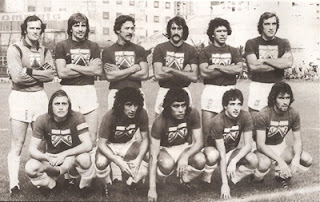In the vast Argentine football universe to go to the bottom is useless. Third level is not even near bottom – from there emerged a single club winning promotion to the Second Division:
Talleres, hailing from Remedios de Escalada, Greater Buenos Aires. Not to be confused with much better known Talleres (Cordoba), this is one of the countless small clubs in the great city. Not an young one either – founded in 1906 – but with more than modest history. Winning was not the club's forte – for the most of its existence, the only question was mere survival. It went through many amalgamations and name changes, and earned the implausible nickname 'Las Tallarines' or 'the Noodles'. The biggest success of the club was winning promotion to Second Division in 1970. In 1978 they repeated the same and in 1979 were to try to avoid going back to third level. But good for them for the moment – up they went.
Two clubs were going down in the upper league – it consisted of 18 teams, one relegated normally. However, the First Division was reduced from 21 to 20 teams for the next season, so two clubs had to go down from the Second Division. San Telmo finished last and down they went, but the two clubs ending just above them had to play a relegation play-off. Villa Dalmine won it 2-0 and Lanus went down. Today it may appear weird, but Lanus was a weak club in the 1970s.
Up the scale – nothing really interesting. A bunch of clubs playing in the second division more or less for ever. Even at the very top there was not a great battle – Tigre finished 4th, four points ahead of Defensores de Belgrano, but 3 points behind Los Andes. However, Los Andes was 5 points behind the second placed Almirante Brown. Which were not much of a challenger either, finishing 4 points behind the champions. Ferro Carril Oeste dominated the league, ending with round 50 points. They were the only club in the league not losing a home match. Good numbers, solid year, yet, this was still second level...
Confident winners, promoted to First Division: standing from left: Rubén Sánchez, Carlos Arregui, Tagliani, Bartolomei, Albariño, Rocchia.
Crouching: Héctor Arregui, Apariente, Molina, Crocco , Lucco.
Naturally, no great stars here. In the team, but not on this photo were two interesting youngsters – Hector Cuper (b. 1955), the future great coach, and Oscar Garre (b, 1956), a future national team player. Neither was famous yet – and not a big hopeful like Maradona. Apart from its amusing name – it is named after railroad company – nothing else to tell... yet. Nobody was in position to see what will happen in the next few. In retrospect, it was the beginning of the great ascent of the so far modest Buenos Aires club. It started in 1978, when nothing was really expected from the club.



